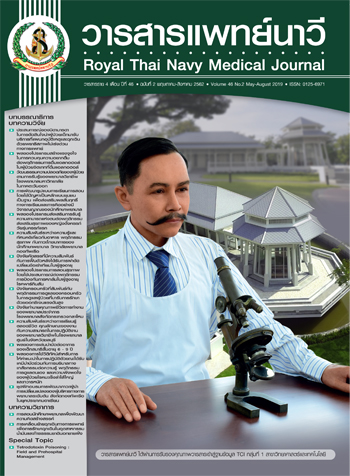Patient Safety Culture as Perceived by Professional Nurses in a University Hospital in the Eastern Region
Main Article Content
Abstract
The purposes of this research were to study the patient safety culture as perceived by professional nurses at university hospitals in eastern region of Thailand and to compare the differences in perception of patient safety culture as classified by agency level, hospital level and the results of perception that covers the safety of patients in a total of 12 aspects. By simple sampling method, the 102 samples of professional nurses who work in inpatient and outpatient sections of nursing service division were selected. The research instruments consist of personal data questionnaires and culture safety questionnaires with reliability based on Cronbach’s alpha coefficient) equal to 0.78. The descriptive statistic, one way ANOVA and Independent t-test were used in data analysis.
The results of patient safety culture dimensional study revealed that the overall patient safety culture grade of “high” (M = 3.53, SD = 0.36). There are seven unit-level aspects of patient safety culture grade of “high”. However, five unit-level aspects of patient safety are “moderate” grade in aspects of frequency of event reporting, teamwork across hospital units, hospital handoffs and transitions, staffing, and hospital management support for patient safety (M = 3.47, SD = 1.04; M = 3.37, SD = 0.75; M = 3.15, SD = 0.79; M = 3.10, SD = 0.73, respectively). There was no significant difference in safety culture perception of professional nurses as classified by age, years of experience, and the safety culture training. (F2,99 = 2.49, p = .08; F2,99 = 2.67, p = .07; t100 = .66, p = .14, respectively)
According to the research, five unit-level aspects of patient safety are “moderate” grade in aspects of frequency of event reporting, teamwork across hospital units, hospital handoffs and transitions, staffing, and hospital management support for patient safety are at a moderate aspect. There is a suggestion that the administration should plan and promote the management in patient safety culture in hospital and manage appropriate allocation between staffs and workloads issues in order to improve the patient safety.
Article Details

This work is licensed under a Creative Commons Attribution-NonCommercial-NoDerivatives 4.0 International License.
References
2. Sangounsiritham U. Management for creating safety culture in nursing service. Nursing Journal 2011;38(3):168-77. (in Thai).
3. Leotsagos A. Health focus. [Internet]. [cited 2017 June 1]. Available from: https://www.hfocus.org/ content/2014/09/8177.
4. Jirapaet V, Jirapaet K. Patient safety management, process concept and clinical safety practices. Bangkok: Darnsutha Press; 2007. (in Thai).
5. National Health Security Office. Universal health coverage annual report 2014. [Internet]. [cited 2017 November 1]. Available from: http://www.nhso.go.th.
6. Nieva VF, Sorra J. Safety culture assessment: a tool for improving patient safety in healthcare organizations. [Internet]. [cited 2017 January 17]. Available from: http://qualitysafety.bmj.com/ content/12/suppl_2/ii17.long.
7. Cooper MD. Toward a model of safety culture. [Internet]. [cited 2016 November 20]. Available from: http://www.behavioral-safety.com/ articles/Towards a model_of_safety_culture.pdf.
8. Muangsorot R. Safety culture: integration factor for sustainable success of organization. [Internet]. [cited 2015 April 18]. Available from: http://journal.pim.ac.th.
9. Kaeotawe A, Wongkittithawor J. Safety culture of operating room personnel in Songklanagarind Hospital. Songklanagarind Medical Journal 2010;28(3):116-23. (in Thai).
10. National Health Security Office. Patient safety culture. [Internet]. [cited 2015 November 14]. Available from: http://www.med.cmu.ac.th/hospital/ha/HA/Plates/ HA 602 25-26 มีนาคม 56/safety culture clinic 20101013.pdf.
11. Thatreenaranon S. Factors affecting patient safety culture in Somdet Chaopraya Institute of Psychiatry. [Master’s Thesis, Faculty of Nursing]. Sukhothai Thammathirat Open University; 2011. (in Thai).
12. Bureau of Policy and Strategy. Public Health Statistics A.D. 2015: strategy and planning division, ministry of public health. [Internet]. [cited 2017 February 13]. Available from: http://bps.moph.go.th/new_bps/sites/default/files/health_statistic 2558.pdf.
13. Chanpanyasakun A. Situational analysis of risk management in the pediatric ward 3, Maharaj Nakorn Chiang Mai hospital. [Master’s Thesis, Faculty of Nursing]. Chiang Mai University; 2010. (in Thai).
14. Sothasathien S. Concepts and theories about knowledge, attitude and behavior. [Internet]. [cited 2017 February 13]. Available from: http://www.novabizz.com.
15. Reason J. Managing the risks of organizational accidents. England: Ashgate Publishing Limited; 1997.
16. Vincent C, Taylor-Adams S, Stanhope N. Framework for analyzing risk and safety in clinical medicine. [Internet]. [cited 2016 November 20]. Available from: https://spiral.imperial.ac.uk/bitstream/10044/1/9890/6/Vincent%20Adams%20Stanhope%20BMJ%201998%20Framework%20for %20analysis.pdf.
17. Nieva VF, Sorra J. Hospital survey on patient safety culture. [Internet]. [cited 2015 November 14]. Available from: https://proqualis.net/ sites/proqualis.net/ files/User%20guide%20HSOPSC.pdf.
18. Bartlett JE, Kotrlik JW, Higgins C. Organizational research: determining appropriate sample size in survey research. Information Technology, Learning, and Performance Journal 2001;19(1):43-50.
19. Koatsriwong S. Patient safety culture, perceived by staff nurses in the Crown Prince Hospitals Thailand. [Master’s Thesis, Faculty of Nursing]. Khon Kaen University; 2014. (in Thai).
20. Mueangsuriya S. Nurse’s perception on patient safety culture and incidence of adverse events in Chiang Saen Hospital, Chiang Rai Province. Nursing Public Health and Education Journal 2013;14(3):42-53. (in Thai).
21. Kilakuldilok P. Safety culture of registered nurses who work on Offices of Public Health in Pathum Thani Province. [Master’s Thesis, Faculty of Public Health]. Khon Kaen University; 2010. (in Thai).
22. Vitawas O’ Ran S. Gen Y: How to make them work. Bangkok: Bangkok Business Biz Books; 2007. (in Thai).
23. Srisathitnarakun B. Leadership and strategic management in nursing organization for the 21th Century. 2nd ed. Bangkok: Chulalongkorn University Press; 2007. (in Thai).
24. Sukosit S. Safety culture of professional nurse in Police General Hospital. Journal of the Police Nurse 2014;6(1):119-29. (in Thai).
25. Sukruaen S. Factor affecting occupational safety awareness of registered nurses in Somdech Phra Pinklao Hospital. Royal Thai Navy Medical Journal 2015;42(3):43-60. (in Thai).
26. Benner P. From novice to expert. California: Addison-Wesley; 1984.


